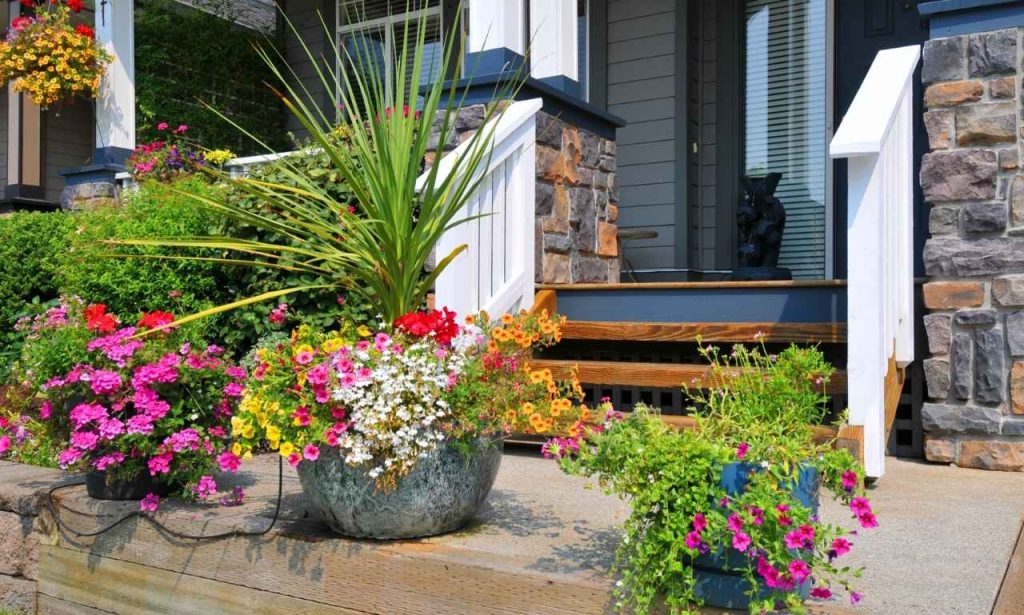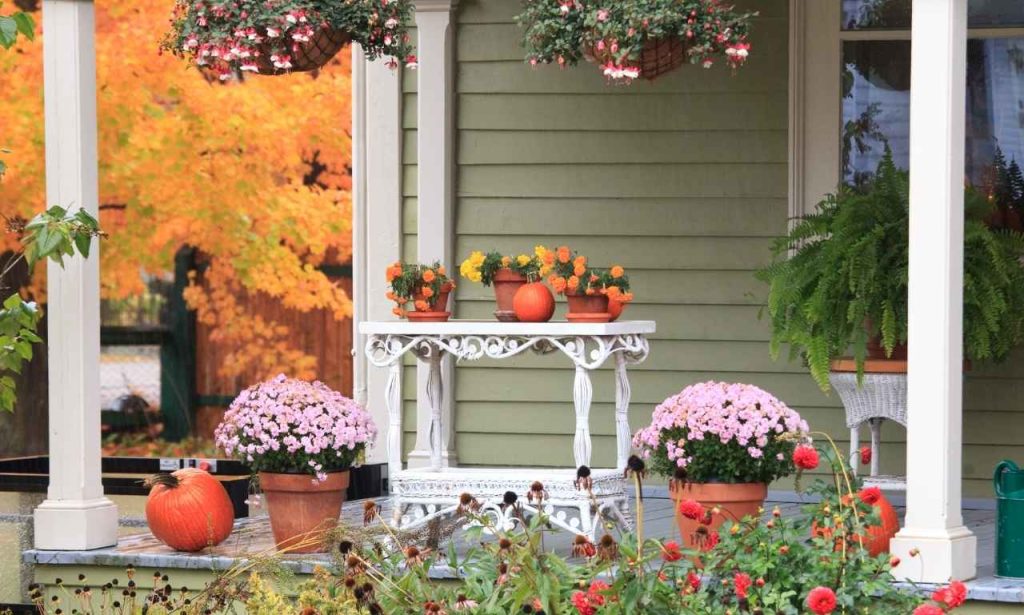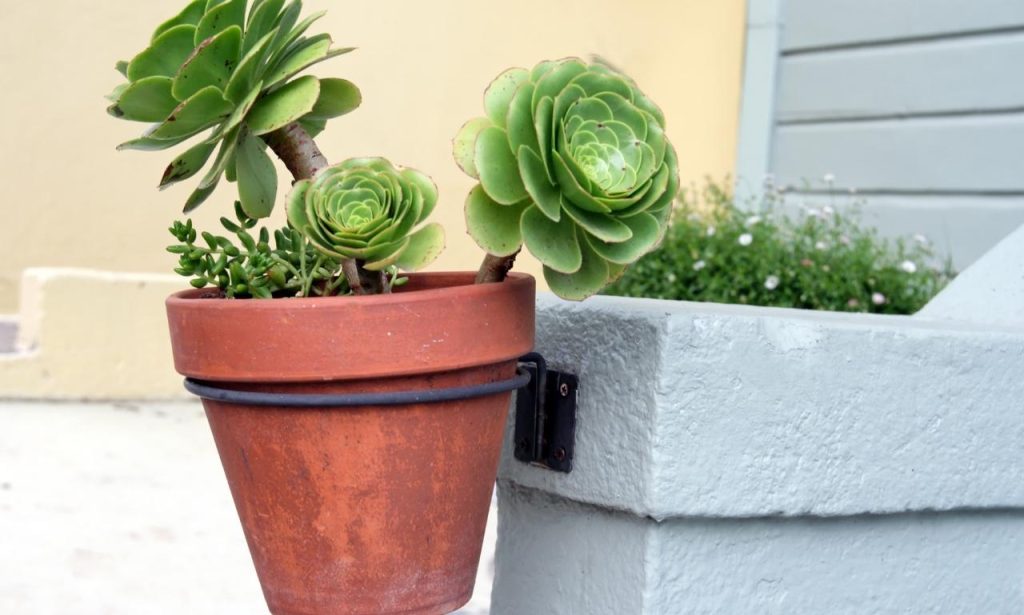Spring has finally arrived, offering the perfect opportunity to refresh your front porch. I can’t tell you how often I’ve seen a beautiful home with a neglected porch that doesn’t do it justice. Your porch creates that crucial first impression, welcoming guests and hinting at what awaits. Whether you have a sprawling wraparound porch or just a tiny stoop, the right decorative choices can create an inviting outdoor space that feels like an extension of your home. Let’s dig into front porch decorating ideas for spring.
Spring Porch Decor

Spring porch decor is about awakening the senses after winter’s long slumber. Think beyond hanging a basic wreath and create a cohesive look that embraces the season’s renewal. Fresh colors like soft blues, gentle pinks, and sunny yellows work beautifully this time of year.
I’ve found that incorporating natural elements makes the most significant difference in creating an authentic spring charm. Wooden accents provide warmth, while floral elements bring that essential touch of seasonal color. My neighbors stopped me twice last week to comment on my blue and white theme with natural wood accessories.
Your porch can become a usable living space during these mild spring months. Even minor updates make a substantial difference—swapping out pillows, adding a new doormat, or hanging string lights can transform the entire feel. The key is creating a space where you want to spend time, perhaps with your morning coffee or an evening glass of wine.
Where to Purchase Decor
Finding the perfect decor pieces doesn’t have to be complicated or expensive. I’ve discovered amazing items in the most unexpected places. Target and HomeGoods consistently offer affordable seasonal items that look far more expensive than their price tags suggest.
Don’t overlook local nurseries for plants and flowers with a character that big box stores simply don’t carry. One small nursery near me sells the most gorgeous hanging ferns that instantly elevate any porch setting. For unique handmade items, Etsy remains my go-to source for custom wreaths and door signs.
Some of my favorite pieces have come from weekend trips to antique shops and flea markets. Last year, I stumbled upon a vintage watering can that inspired my entire porch design. The patina and character simply can’t be replicated in mass-produced items.
For convenience, Amazon delivers a vast selection of outdoor pillows and string lights right to your door. If your style leans more upscale, Ballard Designs specializes in higher-end decor that stands the test of time. Their lanterns lasted through three seasons of heavy use on my porch.
Craft stores like Michaels and Hobby Lobby stock all the supplies you’ll need if you prefer making your own decorations. The DIY approach often yields the most satisfying results and customized pieces that perfectly match your vision.
How To Make A Wood Bead Wreath
Creating your own wood bead wreath adds a personal touch that store-bought options can’t match. Plus, you’ll save significant money while getting exactly what you want.
For this project, gather wooden beads in various sizes (available at craft stores), floral wire, and spring embellishments like faux flowers or greenery. Begin by shaping your floral wire into a circle of your desired size. Once you’ve added all your beads, leave enough excess wire on each end to secure them together.
Thread the wooden beads onto the wire, mixing sizes for visual interest. Continue until the entire wire is covered, then twist the ends together firmly to create a secure base. For fuller wreaths, consider adding a second layer of beads.
Here’s where you can make it your own—attach spring elements like small faux flowers, greenery, or even tiny decorative bird’s nests using hot glue or additional wire. I’ve found that less is often more with these wreaths; a few well-placed accents look more sophisticated than an overcrowded design.
Apply a light wood stain to the beads before assembly for a warmer look. Just be sure to let them dry completely before stringing them. Finish with a natural burlap bow or colored ribbon that complements your porch color scheme.
The beauty of these wreaths lies in their versatility. They work equally well with farmhouse, modern, or traditional exterior styles, and the natural wood adapts beautifully to any color palette you choose.
How To Decorate A Spring Porch
A logical approach to your spring porch decoration project will produce the best outcomes. The first step requires a complete cleaning process, including sweeping debris while washing windows and rinsing furniture surfaces. Your space will appear much better after an essential cleaning operation.
Before moving forward, check your porch for maintenance requirements that develop during winter. A single layer of paint applied to railings and furniture will restore a fresh appearance to the entire area. After cleaning your space, you should develop a color plan that matches your house’s exterior.
To balance porch design, start with oversized items, then move toward middling furnishings, followed by tiny decorative elements. The method produces an organized design by avoiding excessive clutter.
Your porch needs seating if there is enough space to become functional. A modest bench or chair allows guests to stay and relax. Position decorative planters near your entry door to improve your appearance and show off architectural design elements. A wreath representing seasonal trends establishes your color theme combined with a welcoming doormat, which serves both purpose and personality.
Remember lighting for evening enjoyment—solar lanterns, string lights, or candles in hurricane glasses create a wonderful ambiance as dusk falls. Finally, add textiles like outdoor pillows and a lightweight throw to make the space feel cozy and intentional.
Tips and Tricks for Spring Porch Decor
Over years of seasonal decorating, I’ve collected insider tips that make a substantial difference. Always choose weather-resistant materials for items fully exposed to the elements. Spring weather can be unpredictable, and nothing’s more disappointing than damaged decor after one rainstorm.
Group decorative items in odd numbers—three, five, or seven—as this arrangement is more visually appealing than even numbers. Vary textures throughout your display to add depth and interest; mixing rough and smooth, shiny and matte, creates a more sophisticated look.
Command hooks have saved many of my decorating schemes, especially in rental properties. They provide damage-free hanging solutions for wreaths, hanging plants, and string lights. For an evening ambiance, solar-powered lights eliminate the need for outdoor outlets while reducing your energy costs.
Consider double-sided seasonal flags that allow quick changes as holidays come and go throughout spring. Keep a weatherproof storage container nearby to protect pillows and other non-waterproof items quickly during unexpected showers.
Create A Focal Point
Every well-designed porch needs a clear focal point that anchors the space and guides the eye. Your front door naturally serves this purpose when painted in a bold color that contrasts with your home’s exterior. If painting isn’t an option, a wreath of significant statement creates an immediate visual impact.
Symmetrical elements like matching planters or lanterns flanking your entrance create balance while framing your focal area. For larger porches, a distinctive piece of furniture—perhaps a colorful bench or unique rocking chair—can become the centerpiece around which other elements revolve.
Lighting is crucial in establishing focal points, especially in the evening hours. Directing soft illumination toward your main feature naturally draws the eye. Remember that multiple competing focal points create visual confusion, so choose one strong element for maximum impact.
Mix & Match

The most interesting porches combine elements rather than matching everything perfectly. This mix-and-match approach creates dynamic, personalized spaces with authentic character. Try pairing vintage and modern pieces—perhaps a contemporary planter holding flowers beside an antique milk can or weathered wooden crate.
Different patterns work beautifully together when they share a standard color. Don’t be afraid to combine stripes, florals, and geometric designs if they include the same blue, green, or whatever your accent color might be.
Metallic accents mixed with natural materials create wonderful textural contrasts. A copper lantern near a woven basket or wooden bench adds unexpected sophistication. Various flower types combined in one arrangement offer more visual interest than single varieties. The key is maintaining some connecting thread—color, texture, or theme—throughout your varied pieces.
Add Plants & Flowers to Your Spring Porch
Nothing says spring like fresh greenery and blooms. Ferns in hanging baskets add lush texture and graceful movement in spring breezes. Classic spring bulbs like tulips and daffodils provide instant color in pots or planters. For fragrance, consider lavender or herbs like mint and rosemary, which offer both aroma and usefulness.
Window boxes filled with pansies or violas add character at eye level. Climbing plants like jasmine or clematis transform a plain trellis into a living focal point. For low-maintenance options, succulents require minimal watering while providing interesting shapes and textures.
Consider light conditions carefully when selecting plants. What works on my sun-drenched, southern-facing porch might fail in your shadier setting. Container gardens offer flexibility, allowing you to move plants as light patterns change throughout the season.
Porch Planters

Selecting the right planters elevates your entire spring porch design. For small porches, tiered planters maximize vertical space without cluttering the floor. Self-watering containers reduce maintenance while keeping plants healthier during busy spring schedules.
Material choices matter both aesthetically and practically. Galvanized metal planters add farmhouse charm, while colorful ceramic pots introduce additional accent colors. For durability, consider lightweight resin planters that resemble stone but without the excessive weight or cost.
When floor space is limited, hanging planters and window boxes attach directly to railings or overhangs. Large statement planters often have a greater impact than several small pots scattered around. Always consider drainage needs to prevent water damage to your porch surfaces.
Group containers in odd numbers for more visually pleasing arrangements. Varying heights create a natural flow, guiding the eye through your porch design. Don’t forget to include planters in different shapes—round, square, rectangular—for additional interest.
Conclusion
Your spring porch makes lasting first impressions, greeting you and your guests at home each day. A quality selection of decorations turns this transitional area into an enchanting seasonal oasis, improving your daily activities.
Small changes, such as fresh flowers, updated textiles, and a new wreath, produce substantial visual improvements at minimal cost and effort. To develop your decorative choices, you should connect with your own preferences instead of following fad-based rules.
Sealed building materials protect your space’s visual appeal from spring weather challenges. Your spring decoration project must begin with proper cleaning, followed by a unified color arrangement and seasonal elements that capture renewal.
Creating a welcoming atmosphere that beckons guests to linger requires attention to both aesthetics and comfort. Your refreshed porch becomes an extension of your living space during pleasant weather—a place to enjoy morning coffee, evening conversations, or quiet moments of reflection.
The effort you put into seasonal decorating enhances your home’s value and your everyday enjoyment. After all, your porch is the threshold between your private world and the public one—make it a space that brings you joy each time you cross it.
Also Read: How to Keep a Clean House With Minimal Effort
FAQs
Seasonal changes work best, with minor updates for holidays or special occasions.
Choose weather-resistant materials and use protective sprays on less durable items.
Solar string lights, lanterns with battery-operated candles, and low-voltage pathway lights create ambiance.
Consider your home’s exterior colors and select complementary seasonal hues that reflect your style.


